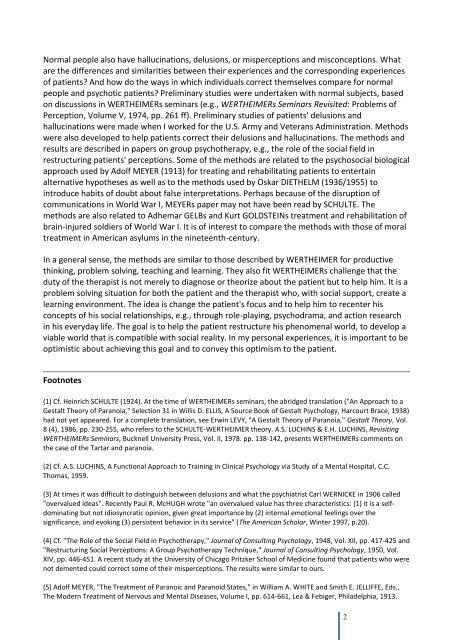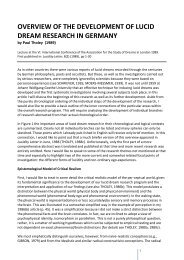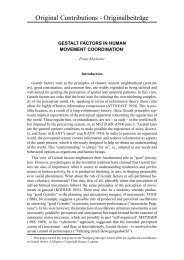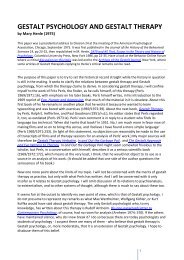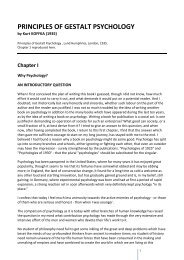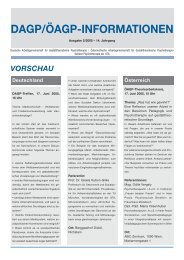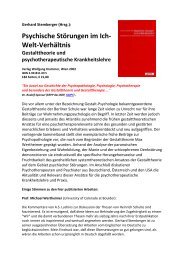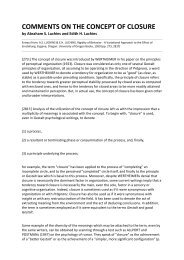on schulte, wertheimer, and paranoia - Society for Gestalt Theory ...
on schulte, wertheimer, and paranoia - Society for Gestalt Theory ...
on schulte, wertheimer, and paranoia - Society for Gestalt Theory ...
You also want an ePaper? Increase the reach of your titles
YUMPU automatically turns print PDFs into web optimized ePapers that Google loves.
Normal people also have hallucinati<strong>on</strong>s, delusi<strong>on</strong>s, or mispercepti<strong>on</strong>s <strong>and</strong> misc<strong>on</strong>cepti<strong>on</strong>s. Whatare the differences <strong>and</strong> similarities between their experiences <strong>and</strong> the corresp<strong>on</strong>ding experiencesof patients? And how do the ways in which individuals correct themselves compare <strong>for</strong> normalpeople <strong>and</strong> psychotic patients? Preliminary studies were undertaken with normal subjects, based<strong>on</strong> discussi<strong>on</strong>s in WERTHEIMERs seminars (e.g., WERTHEIMERs Seminars Revisited: Problems ofPercepti<strong>on</strong>, Volume V, 1974, pp. 261 ff). Preliminary studies of patients' delusi<strong>on</strong>s <strong>and</strong>hallucinati<strong>on</strong>s were made when I worked <strong>for</strong> the U.S. Army <strong>and</strong> Veterans Administrati<strong>on</strong>. Methodswere also developed to help patients correct their delusi<strong>on</strong>s <strong>and</strong> hallucinati<strong>on</strong>s. The methods <strong>and</strong>results are described in papers <strong>on</strong> group psychotherapy, e.g., the role of the social field inrestructuring patients' percepti<strong>on</strong>s. Some of the methods are related to the psychosocial biologicalapproach used by Adolf MEYER (1913) <strong>for</strong> treating <strong>and</strong> rehabilitating patients to entertainalternative hypotheses as well as to the methods used by Oskar DIETHELM (1936/1955) tointroduce habits of doubt about false interpretati<strong>on</strong>s. Perhaps because of the disrupti<strong>on</strong> ofcommunicati<strong>on</strong>s in World War I, MEYERs paper may not have been read by SCHULTE. Themethods are also related to Adhemar GELBs <strong>and</strong> Kurt GOLDSTEINs treatment <strong>and</strong> rehabilitati<strong>on</strong> ofbrain-injured soldiers of World War I. It is of interest to compare the methods with those of moraltreatment in American asylums in the nineteenth-century.In a general sense, the methods are similar to those described by WERTHEIMER <strong>for</strong> productivethinking, problem solving, teaching <strong>and</strong> learning. They also fit WERTHEIMERs challenge that theduty of the therapist is not merely to diagnose or theorize about the patient but to help him. It is aproblem solving situati<strong>on</strong> <strong>for</strong> both the patient <strong>and</strong> the therapist who, with social support, create alearning envir<strong>on</strong>ment. The idea is change the patient's focus <strong>and</strong> to help him to recenter hisc<strong>on</strong>cepts of his social relati<strong>on</strong>ships, e.g., through role-playing, psychodrama, <strong>and</strong> acti<strong>on</strong> researchin his everyday life. The goal is to help the patient restructure his phenomenal world, to develop aviable world that is compatible with social reality. In my pers<strong>on</strong>al experiences, it is important to beoptimistic about achieving this goal <strong>and</strong> to c<strong>on</strong>vey this optimism to the patient.Footnotes(1) Cf. Heinrich SCHULTE (1924). At the time of WERTHEIMERs seminars, the abridged translati<strong>on</strong> ("An Approach to a<strong>Gestalt</strong> <strong>Theory</strong> of Paranoia," Selecti<strong>on</strong> 31 in Willis D. ELLIS, A Source Book of <strong>Gestalt</strong> Psychology, Harcourt Brace, 1938)had not yet appeared. For a complete translati<strong>on</strong>, see Erwin LEVY, "A <strong>Gestalt</strong> <strong>Theory</strong> of Paranoia," <strong>Gestalt</strong> <strong>Theory</strong>, Vol.8 (4), 1986, pp. 230-255, who refers to the SCHULTE-WERTHEIMER theory. A.S. LUCHINS & E.H. LUCHINS, RevisitingWERTHEIMERs Seminars, Bucknell University Press, Vol. II, 1978. pp. 138-142, presents WERTHEIMERs comments <strong>on</strong>the case of the Tartar <strong>and</strong> <strong>paranoia</strong>.(2) Cf. A.S. LUCHINS, A Functi<strong>on</strong>al Approach to Training in Clinical Psychology via Study of a Mental Hospital, C.C.Thomas, 1959.(3) At times it was difficult to distinguish between delusi<strong>on</strong>s <strong>and</strong> what the psychiatrist Carl WERNICKE in 1906 called"overvalued ideas". Recently Paul R. McHUGH wrote "an overvalued value has three characteristics: (1) it is a selfdominatingbut not idiosyncratic opini<strong>on</strong>, given great importance by (2) internal emoti<strong>on</strong>al feelings over thesignificance, <strong>and</strong> evoking (3) persistent behavior in its service" (The American Scholar, Winter 1997, p.20).(4) Cf. "The Role of the Social Field in Psychotherapy," Journal of C<strong>on</strong>sulting Psychology, 1948, Vol. XII, pp. 417-425 <strong>and</strong>"Restructuring Social Percepti<strong>on</strong>s: A Group Psychotherapy Technique," Journal of C<strong>on</strong>sulting Psychology, 1950, Vol.XIV, pp. 446-451. A recent study at the University of Chicago Pritzker School of Medicine found that patients who werenot demented could correct some of their mispercepti<strong>on</strong>s. The results were similar to ours.(5) Adolf MEYER, "The Treatment of Paranoic <strong>and</strong> Paranoid States," in William A. WHITE <strong>and</strong> Smith E. JELLIFFE, Eds.,The Modern Treatment of Nervous <strong>and</strong> Mental Diseases, Volume I, pp. 614-661, Lea & Febiger, Philadelphia, 1913.2


